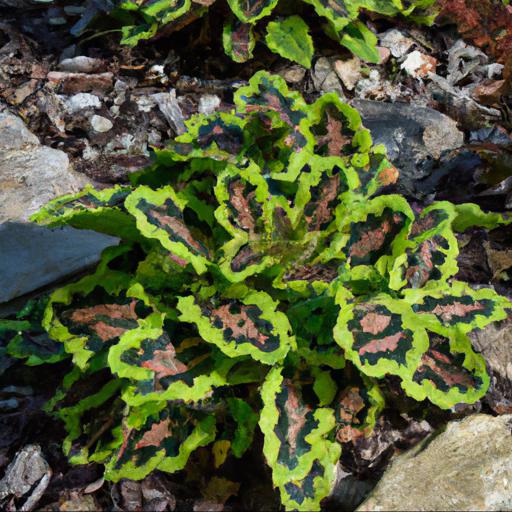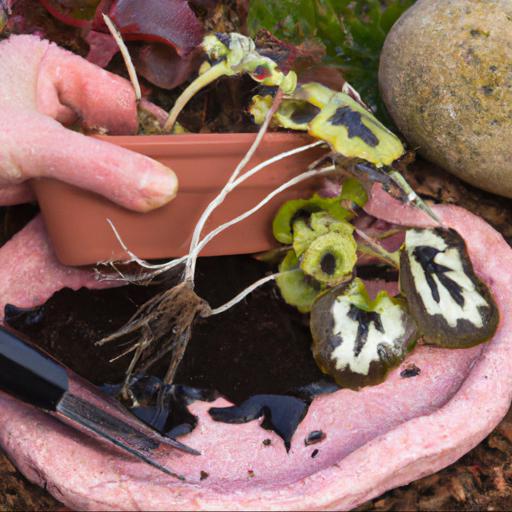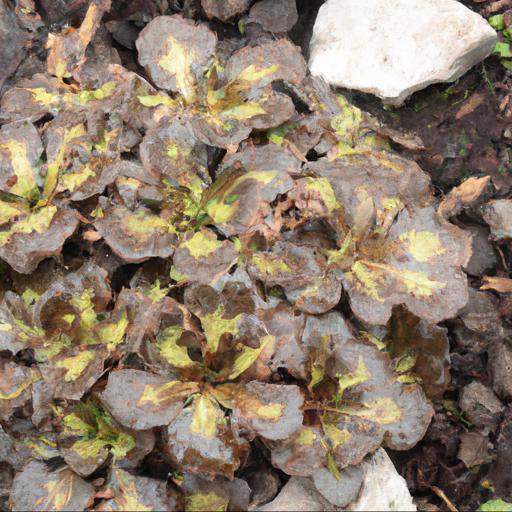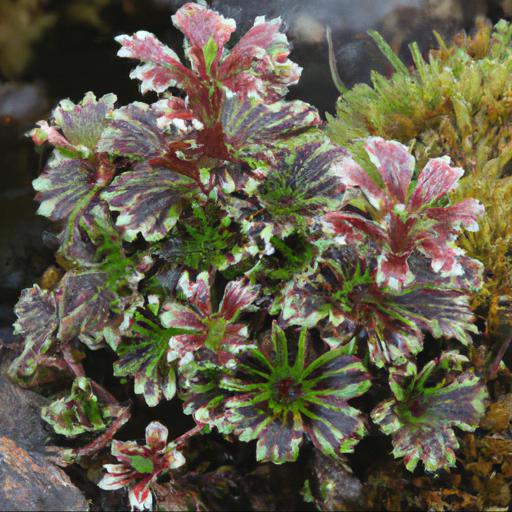Saxifraga x urbinum variegata, commonly known as London Pride, is a beautiful, evergreen perennial plant with a low-growing, spreading habit. It is native to the Alps, Pyrenees and Apennines, but has been cultivated and hybridized for centuries in Europe and North America. Its small, round, variegated leaves are green, white and pink, and its clusters of vibrant pink flowers appear from late spring to early summer.
London Pride is easy to grow and maintain, and its compact size makes it perfect for rock gardens, containers, and ground cover. It is also a great choice for adding a splash of color to any garden.
Benefits of growing saxifraga x urbinum variegata

Saxifraga x urbinum variegata is a beautiful, compact, evergreen perennial that provides year-round interest to the UK garden. It reaches a maximum height of 15 cm, with a spread of 25 cm, making it ideal for containers or rockery gardens.
The leaves of this plant are mottled green and white, and the flower stems are produced in late spring to early summer, producing white and pink flowers. Growing Saxifraga x urbinum variegata provides a range of benefits, making it an excellent garden addition. Firstly, it is an excellent source of nectar for pollinators such as bees, butterflies and hummingbirds.
This provides a natural food source for these beneficial insects, which are vital for our UK ecosystems. What’s more, the flowers of Saxifraga x urbinum variegata are exceptionally long-lasting, meaning they provide an all-year-round food source for pollinators.
In addition, Saxifraga x urbinum variegata is extremely low-maintenance, requiring little to no additional care once it is planted. This makes it an ideal choice for busy gardeners, adding vibrant colour and interest without having to spend hours keeping it in good health. And because it grows in compact clumps, it does not spread rapidly, making it an ideal choice for those with a small garden, patio or container.
Finally, Saxifraga x urbinum variegata is one of the toughest plants available in the UK. It can easily survive temperatures down to -20°C and low light, meaning it is capable of withstanding the typically harsh UK climate.
This, combined with its long-lasting flowers, mottled leaves and ease of maintenance, means Saxifraga x urbinum variegata is an excellent choice for all levels of gardeners, no matter how much time and expertise they have.
Tips for planting and caring for saxifraga x urbinum variegata

Saxifraga x urbinum variegata is a versatile evergreen perennial with variegated foliage, small clusters of white flowers in late spring, and a treasure trove of uses in the garden. It makes an excellent choice for small gardens of any size where you want an eye-catching and easy to maintain space.
As long as you ensure that the soil and the environment are suitable for it, saxifraga x urbinum variegata can thrive for many years in your garden. When it comes to planting saxifraga x urbinum variegata, you should opt for a moderately sheltered location with partial shade, as this plant has delicate leaves that can easily burn in direct sunlight. To ensure it grows to its full potential, use a well-draining soil and add a slow release fertiliser to help it grow through the first growing season.
When caring for saxifraga x urbinum variegata, one of the most important tasks is watering the plant. It will appreciate weekly watering in the summer months, but be sure to keep the soil moist but not wet.
Furthermore, you should protect it from cold snaps either by covering it with fleece or moving it to a frost-protected spot. If you’re prepared to give saxifraga x urbinum variegata the right environment and care, it could thrive for years in your garden. For a low-maintenance garden, you could use saxifraga x urbinum variegata to form masses of soft foliage and cover barren patches.
This versatile plant can also be considered for planting around paths, driveways or patio edges. With its dainty leaves, white flowers and well-rounded habit, saxifraga x urbinum variegata is an excellent companion for other low-maintenance perennials such as heuchera, epimedium or hellebores.
As long as you provide it with a suitable growing environment and the right care, saxifraga x urbinum variegata will provide a striking backdrop for your garden year after year.
Common problems with saxifraga x urbinum variegata

Saxifraga x urbinum variegata, or commonly known as London Pride, is an evergreen, clump-forming perennial plant that is mostly seen in British gardens. It is native to central and southern Europe, where it grows in woodlands, rocky scrub, and grasslands. London Pride has distinctive, variegated foliage, with dark green and cream leaves arranged in bright rosettes.
In sunny and sheltered conditions, it produces masses of funnel-shaped small pinkish-purple flowers in spring and sometimes again in autumn. While London Pride can make a beautiful addition to any garden, it does come with its own unique set of challenges.
One of the most common problems with this plant is root rot. The telltale sign of this type of infection is a yellowing or wilting of the lower leaves. High humidity and poorly draining soil can lead to root rot, so it’s important to make sure your plant is in an area with plenty of air circulation and that the soil is well-draining.
Another potential issue with Saxifraga x urbinum variegata is fungal diseases, such as powdery mildew and rust. These can manifest as discolored or spotted leaves, or even powdery white fungus on the leaves and stems.
To help prevent this, it’s important to provide your London Pride with ample sun and air flow. If you do notice fungal diseases, remove the infected parts of the plant, clean your garden tools to avoid spreading the disease, and be sure to discard the plant debris rather than leaving it in your garden. Providing your London Pride with the right conditions can help you avoid these common problems.
For best results, make sure to plant your Saxifraga x urbinum variegata in organically rich, well-draining soil in an area with plenty of light and air circulation. With a little love and attention, this attractive variegated perennial can bring a wonderful pop of colour and texture to any British garden.
Conclusion
Saxifraga x urbinum variegata is a beautiful evergreen perennial plant with variegated foliage and charming yellow flowers. It is easy to grow and requires little maintenance.
This plant is perfect for containers, rock gardens and borders. It is also deer and rabbit resistant and can tolerate light shade. With its eye-catching foliage and bright flowers, Saxifraga x urbinum variegata is an attractive addition to any garden.
FAQ
What is the scientific name of Saxifraga x urbinum variegata?
The scientific name of Saxifraga x urbinum variegata is Saxifraga x urbinum ‘Variegata’.
What are the characteristics of Saxifraga x urbinum variegata?
Saxifraga x urbinum variegata is a perennial flowering plant with variegated foliage. It has white-edged green leaves and produces small, white flowers in the spring. It is a low-growing plant, reaching a height of 6-10 inches, and is hardy in USDA Zones 4-8. It prefers partial shade and moist, well-drained soil.
How does Saxifraga x urbinum variegata differ from other varieties of Saxifraga?
Saxifraga x urbinum variegata differs from other varieties of Saxifraga in that it has variegated foliage, with the leaves having a mix of green and white or yellow colors. It also tends to be more compact than other varieties of Saxifraga, with shorter stems and smaller flowers.
What is the ideal growing environment for Saxifraga x urbinum variegata?
The ideal growing environment for Saxifraga x urbinum variegata is one that is moist, well-draining, and has partial shade. It should also have a slightly acidic soil with a pH of 5.5 to 6.5.
How often should Saxifraga x urbinum variegata be watered?
Saxifraga x urbinum variegata should be watered when the top inch of soil feels dry.
What are the common pests and diseases associated with Saxifraga x urbinum variegata?
Common pests and diseases associated with Saxifraga x urbinum variegata include root rot, powdery mildew, aphids, slugs, and snails.

